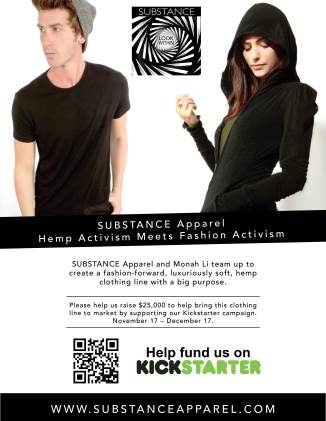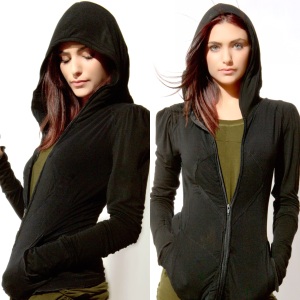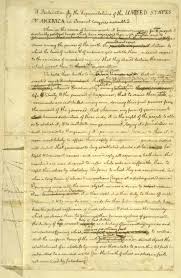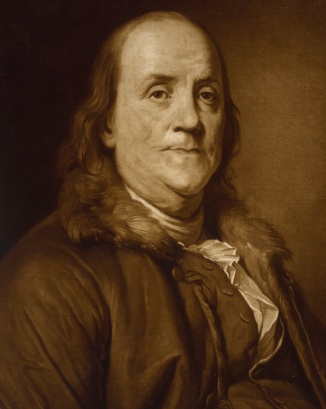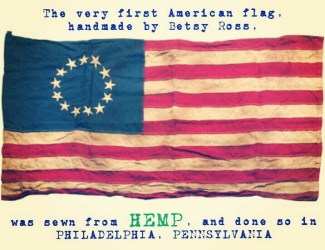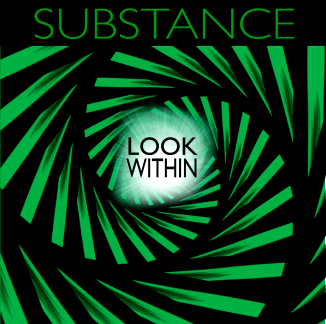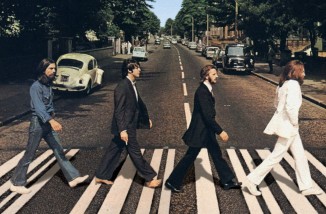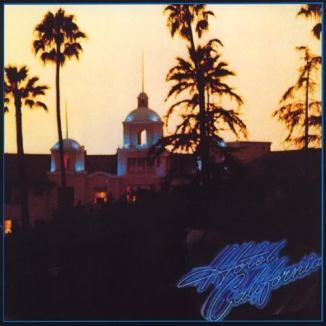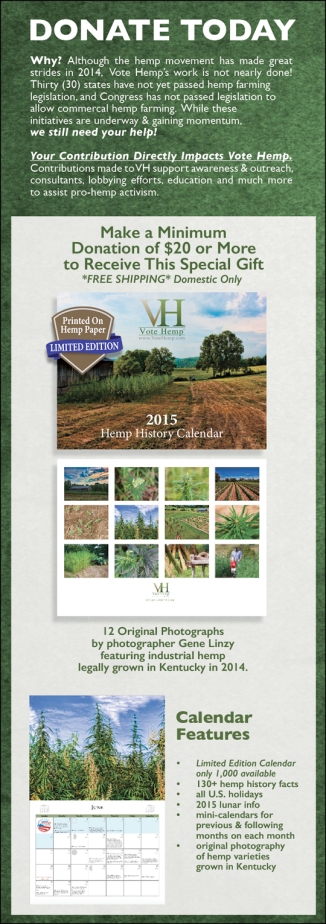Before I ever got into the fashion business, I was a huge fan of Monah Li.
I recently posted this picture of a Monah Li top that I purchased about 17 years ago on my Facebook. It got plenty of likes.
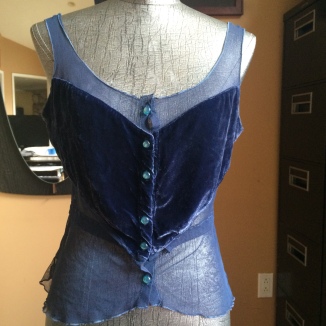
Blue Velvet top by Monah Li
I have many other Monah Li creations, some I wore to pieces and other’s like the one below, is in impeccable shape. I remember wearing this outfit during the holidays with some cool boots and feeling like a walking piece of art. I also remember wearing this dress at home with sandals and my girlfriend Bea stopping by and asking me, “Why are you so dressed up.” The cool thing was that I was comfy in this dress and could even wear it around the house and not feel like I was too dressed up. I love the idea of fashion that is versatile and that is exactly what I planned to create for SUBSTANCE.
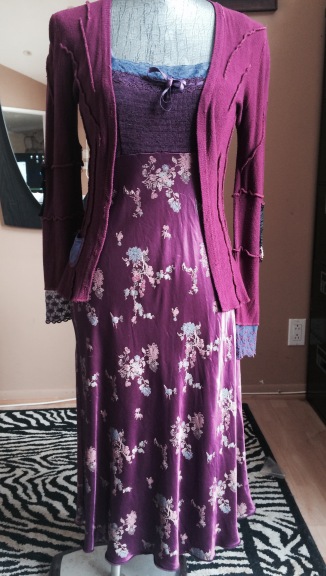
I thought it was so fun to walk around with a garder belt hanging from my sleeves:
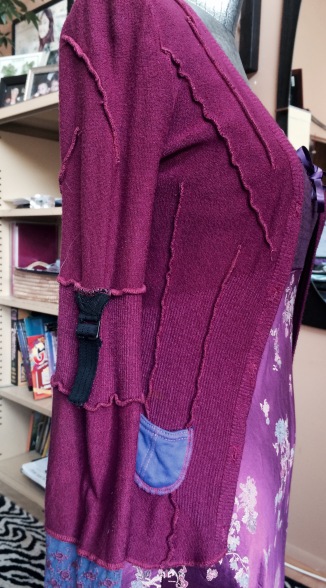
Who thinks of putting a bra strap on the outside? Monah Li totally made this look work. And how beautiful is that lace at the end of the sleeves?
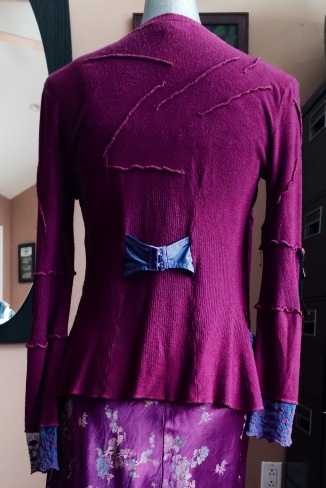
Check out this neckline detail and color. Monah Li’s pieces always had the most amazing dye jobs.
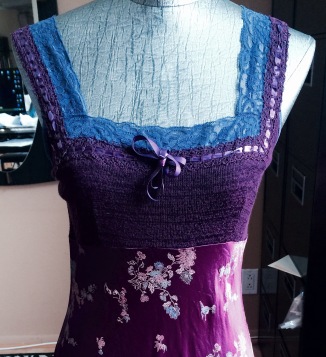
The back is just as pretty. You look just as good going as you do coming!
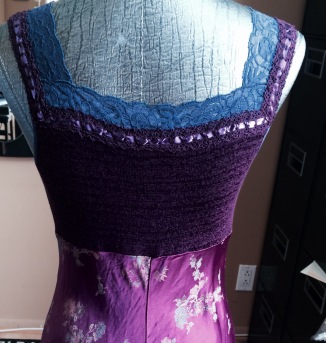
I’ve always had a fascination with Monah Li’s pieces. I was introduced to her apparel by someone I knew at the gym who worked for the fashion industry. I later found out a friend of mine (yes, you Yvonne Fata), who always seemed to know what was hip and happening, had started collecting Monah Li apparel from her Los Feliz boutique.
I always tell people I knew I was in the wrong business when I worked in an office and realized the best part of my work day was choosing my outfit! (Aside from hanging out with my boss, who I adored). I used to love the fine line between dressing professional, but not boring. While I once heard my assistant say she never saw me in the same thing twice, there was one suit that managed to make it into rotation quite often. Of course it was a suit made by Monah Li. This pinstripe suit had an extraordinary fit and that’s exactly what Monah Li is known for. I plan to post pictures of this suit later.
To date, no other designer has moved me like Monah Li. She creates one of a kind pieces that make you feel amazing when you wear them. You just know you’re wearing art. I managed to snag a dozen or so pieces over 15 years ago which I still own to this day and every time I see them or wear them, I would think of Monah, with reverence and gratitude.
Once in a while, I would search for Monah Li pieces on ebay or the internet. I knew that she had taken a job with Bebe and I was very much looking forward to seeing what she and Bebe put out, but alas, it was not meant to be. A victim of growing way too fast with her own line and not jiving with the vision of a “Garmento”, she kind of stepped away from fashion for a bit. I’m not sure what possessed me to look for her on Facebook, but I did and after a few months of being a Facebook friend, I commented on one of her statuses and that lead to a more in depth conversation. I tried my best to not come across as a stalker but I wanted so badly to tell her, “Hey, I have a clothing line! You inspire me! Want to come out and play?” That’s pretty much what I did, though.
My goal with SUBSTANCE has always been to create a sort of playground for creatives. I am totally a big picture girl, sort of a visionary. I had a mom who allowed me to design pieces that she would sew for me, but she never let me touch her sewing machines. I often think, what a huge missed opportunity but I also think the universe expects me to use my talents in other ways. There is too much creative talent out there that can be channeled towards supporting a worthy cause and collaboration just makes sense. My intention with SUBSTANCE has always been to create a space where people can feel good about contributing to something positive. Creating fashion that looks good, feels good and does good! Lots of creatives need this and I believe, this intention can create magic.
I had my eye on a few designers that I wanted to approach. To be honest, Monah originally wasn’t one of them because in my mind, she was out of my league. She’s designed for major celebrities and until recently, I had no idea how to get a hold of her. So when I finally decided to reach out to her on Facebook, I wasn’t sure what to expect but something told me it was meant to be. We exchanged a few messages and I pitched her the idea of collaborating. I’m sure she did a bit of due diligence and understood what I was doing because she enthusiastically responded that she was interested. GREAT! A meeting was set!
A few days later, I dropped by her place for a meeting and to introduce her to my fabric. I drove up to her condo in one of the up-and-coming areas of Los Angeles (Monah is always ahead of her time) and Monah met me at my car. She was wearing pajamas because she was up all night creating. The first thing I thought was, “How the heck does someone make PJ’s look so freaking cool? Then she gifted me this night gown and I understood.
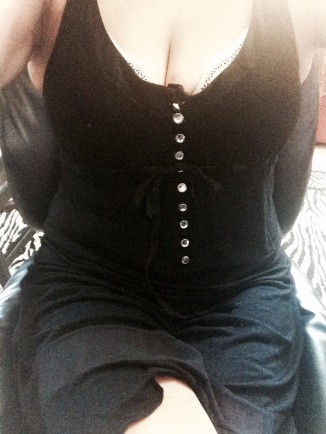
Monah Li nighty
I have probably owned this nighty for two weeks and have worn it almost every day when I get home. I’ve even dressed it up and wore it out!
As soon as I was in the presence of Monah, the chemistry was immediate and my gut told me something amazing is brewing. I don’t think it gets any better than starting out the gate with a Monah Li for SUBSTANCE collection. While I have always known my fabric was special, the added touch that Monah provides with her attention to detail and fit, makes my product extraordinary. I literally left her with a couple of pieces and overnight, she transformed them into something way more special, such as this raglan tee. It went from a simple tee to this in one night!
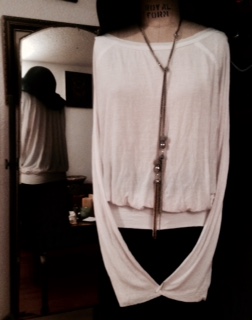
Monah Li and hemp?! I don’t think people expect it but what a boon for fashion this will be. Now maybe some of those hemp fashion blogs will have something exciting to write about.
I found an article Monah wrote for the L.A. Weekly and read it before I actually met her. If you don’t know who Monah is, once you read this, you’ll definitely have an idea. Thank you Monah for your permission to post this. It’s such a great read. Thank you even more for the creative energy you are putting into our next launch. I truly do love you, A LOT!!!
And, by the way, when you read this, please take into account that Monah came to the United States from Vienna at 25, not speaking a lick of English. Now her command of the language is so strong, she’s not only a clothing designer, fine artist, belly dancer, jewelry designer, hand bag designer and shoe designer, she’s a writer as well! Can you say Renaissance Woman?
Hemp fashion just got a lot more interesting! It’s going to be a fun ride!
THE MAKING OF A DESIGNER
THURSDAY, APRIL 3, 2003 | 12 YEARS AGO
“I have heard with admiring submission the experience of the lady who declared that the sense of being well dressed gives a feeling of inward tranquillity, which religion is powerless to bestow.”
–Ralph Waldo Emerson
I have always had more faith in fashion than in God. Let me explain. At 9 years old I began staying up all night making clothes. A typical 3 a.m. would find me, flashlight propped under blankets, feverishly knitting away at a shawl, say, or sewing an entire dress together.
I was driven by the incipient belief that the right garment could save me. Call it dress-as-redemption, fashion as platonic ideal. In a kind of style-based magical thinking I had yet to even articulate, let alone comprehend, I knew in my heart that there existed a garment that could transform me the shame-crazed, prepubescent spawn of a father who had recently taken off with a
Somehow, if I just stopped eating, stayed up late and worked hard enough, I’d create the glorious item that would reveal my true identity. Somewhere in the universe were clothes in which the outcast could ascend to the admired.
I believed that the right clothes could make me perfect. I still do. And so does every woman who has ever slipped into a dressing room, held her breath, and felt that insane, life-affirming rush of hope before stepping in front of the mirror.
Unlike any other art form, in fashion you can create yourself. The journey from nothing into something transforms creator and created. Clothes can give you what the gods forgot. And reinventing yourself through wardrobe is so much more convenient than plastic surgery. What we select to cover our skin announces and idealizes who we want to be which is, by default, almost always what we are not. Witness a generation of suburban white kids in baggy pants trying to look like gangbangers and convicts. Or there’s the Beverly Hills older women who drop a bundle to dress like glitzy streetwalkers.
We also dress to identify ourselves with the tribe we want to be a part of: Slip into a cropped baby T-shirt with a pair of lace-up leather pants and find your inner rock goddess, whether it be Christina Aguilera at 20 or Sheryl Crow for the over-40 woman. Chop off your bangs, put on a ’50s poodle skirt and show that you belong to Silver Lake. And let’s not even get into the people wearing sweatsuits, Juicy Couture or otherwise, who resemble aging infants.
Ideally, design should turn necessity into something that not only pleases the eye but the psyche.
“Art produces ugly things which frequently become beautiful with time. Fashion on the other hand produces beautiful things which always become ugly with time.”
–Jean Cocteau
Until about five years ago, L.A.’s reputation for fashion design barely existed, and was probably best known through the exquisitely tailored clothes of Richard Tyler, who left for New York in 1993. The city was synonymous with bikinis, shorts and mass-produced baby-doll dresses fast, fun products that did nothing to advance design.
During the late ’80s it was all about Melrose Avenue. Retailers such as Tiziana, Black Salad, Ecru and Neo Romance were more famous than the designers they sold. And stores such as Maxfield rarely carried L.A. lines, instead concentrating on European and Japanese designers. In 1989, I along with Elisabetta Rogiani, Rachel London and Maggie Berry came out with designs that weren’t influenced by anything going on elsewhere: a sexy sailor dress for grown-ups, chic crepe tailored frocks, gardens of appliqué flowers, smooth club wear. It was a new look that tapped into a Southern California aesthetic: The fashion press hailed us as wildly original.
Since then designers such as Rick Owens, Eduardo Lucero, Josephine Loka, Alicia Lawhon, Cynthia Vincent and Anna Huling, to name a few, have put L.A. on the map of smart fashionistas. And might I modestly point out a cause I also helped. Nobody had ever looked to L.A. as opposed to Hollywood, which has had a huge influence on fashion as an inspiration for design, but all of a sudden L.A. ideas were taken up and copied everywhere. Mixed fabrics, which was a defining L.A. moment, got picked up by the high-end London house Voyage. The bright colors that infused L.A. wear had an influence on Versace. Alicia Lawhon and I founded CLAD (Coalition of L.A. Designers) in 1998, an organization that intended to make it easier for local designers to show their talent although that hasn’t been entirely successful.
Now 7th on Sixth and Mercedes-Benz have come from New York to sponsor, for the first time, an L.A. Fashion Week. And, also for the first time, L.A.-based Smashbox, the photography studio/cosmetics company/talent agency, is hosting its own Fashion Week. Clearly, someone is taking L.A. more seriously. Having had my share of being this year’s flavor, I found myself rejected by both organizations, too experimental for the mainstream, too traditional for the so-called cutting edge. Fashion, as much as fiction, FM radio or Hollywood movies, labors forever under the dead hand of categorization.
In any case, the lack of pretense and expectation is the best and worst thing about designing here. Fashion in California remains a lot more open-minded than in New York or Paris. There is a lot more room for designers to play around and explore. But we’re still hampered here, in part, because L.A. has yet to develop the kind of support that fashion designers in Italy or France can count on: generous loans for production, state-financed fashion shows and affordable studio space.
Obviously, L.A.’s burgeoning design talent didn’t replace the likes of lowest-lower-low-end manufacturers such as Forever 21, H&M, Rampage, XOXO and moderate pricers such as BCBG, Bebe and Bisou Bisou companies whose sole function in the universe is to get knockoffs out faster than the original creators can even get their own designs into production.
Manufacturers can compete with designer-driven outfits like mine by hiring 9-year-old girls in Bangladesh to sew and embroider and bead their “designs” for 10 cents a day. Even in L.A., the people who sew in legal sweatshops have problems getting paid. Workers who must endure forced and unpaid overtime, the denial of breaks and being cramped together with 50 machines in a sweltering, unventilated sample room continue to be the norm. It’s the ugly side of fashion. (By the way, the organization Sweatshop Watch, http://www.sweatshopwatch.org, does admirable work in this area.)
Of course, it is very seductive to shop at Rampage or Forever 21 trolling for that superhot item that you won’t feel guilty about wearing only once. Naturally, when anything is that cheap, you can bet somebody’s getting fucked on the deal. And it isn’t management.
Tired of competing with giants who blithely rip off our designs and don’t forget, it can take weeks and sometimes months of fittings and alterations to get a perfect design and sample some of us, such as Imitation of Christ, ALF and Show Pony, have resorted to working with vintage or just plain used clothes. Imagine writing a novel and having another author slap her name on it before your publisher could get your book on the shelves, and you’ll begin to comprehend the frustration designers live with.
The companies I mentioned above work with recycled garments not because at one time this was new and fun or not just but because those unique, one-of-a-kind almost-art pieces are nearly impossible to rip off. It’s essentially a defensive maneuver. So garmentos (and this pejorative slang term is the best description for companies such as Mica or XOXO), eat your heart out. Don’t even think about trying to copy my reworked slip made out of six different fabrics, with embroidery from the ’30s, beading from who knows where, and all hand-dyed.
It’s not that different from hip-hop, where one artist can sample another’s virtuosity while still respecting it and assemble it in a brand-new way to come up with something original at the other end. All that and you never have to learn an instrument be it a sewing machine or electric guitar.
I started with cashmere cardigans and lingerie slips. In 1982 they were plentiful and cheap. I grabbed them at the Vienna flea market where they were sold by the pound. The flea market also happened to be the prime heroin cop spot. I could feed my smack and fashion-design habits in one convenient location.
Since the sleeves of the moth-eaten cardigans were always too short, I began adding a piece of velvet to the elbow, and for a tighter fit I sewed long corset-shaped seams and darts from the bust to the hips. Which, in a kind of reverse deconstruction, transformed a dowdy, ill-fitting rag into a sexy, modern jacket. I’d replace the grandma buttons with hook and eye closures to make it look even more like a corset.
In order to banish the dirt and the stink you could smell the desperation of whoever owned these clothes in the first place I needed to wash them. But washing was never enough to make the stains disappear, so I added dye to the wash. And then the most interesting thing happened: Since the various fabrics in my cardigan took on the dye differently, the result was a unique garment.
These reworked slips, tops and sweaters flew off the racks of the boutiques that were willing to sell something new (don’t forget, this was 1982). No matter how many pieces I made, they were gone by the end of the day.
Stretch silk with tulle godets
After a while, though, the constant stink of mold in my loft and the weird bugs that crawled out of the stuff began to get to me. I tried to imagine where the clothes might have been before they ended up on the flea-market asphalt. It was never pretty.
When you cut up old rags, you don’t need to know how to design, drape, make a pattern or sew. A shredded T-shirt does not a designer make though it might make a faux designer wealthy. Hello, M.R.S. These days, design also offers a way to live a rock-star life. Just look at Tom Ford. When it comes to fashion, you can create it, wear it and become your own two-legged gallery. All of which makes for fertile ground for every kind of wannabe to rip out a wardrobe and call herself Coco the Designer.
But can you call yourself a designer just because you kind of taught yourself how to use a sewing machine? Does it help to move fashion forward when stores are loaded with overdyed nylon slips with rhinestone trims? Does the term designer even mean anything when all you need to do is turn a men’s jacket from the Salvation Army inside out and rip the sleeves off?
“Just because someone dances on the weekend doesn’t make them a professional dancer,” says Traffic buyer/manager Carl Dias. And Richard Tyler insists that customers want quality and workmanship, especially in a down economy. I believe that the DIY trend has unleashed a ton of creativity on a stale fashion scene although there is now so much crap in stores that this is in danger of becoming just as watered down and boring as the endless knockoffs from manufacturers.
However, doing up an old-lady skirt by adding seams and fraying the edges might very well lead someone to seek out more traditional training which may, in turn, give them the chops to create even more outlandish designs. Alicia Lawhon, who has a secondary line of reworked used clothing, breaks it down this way: “Whatever you produce, if you stick your name on it, you are responsible.” Which makes sense, to a point.
Ultrasuede jacket with hand-
knit silk collar and glass
buttons
Ultimately, it’s the customer who decides not what’s good and what’s bad, but what she wants to wear (unless she’s a label whore). The woman who sees a dress and falls in love with it couldn’t care less if it was designed by someone with years of training or a creative kid who went wild with a pair of scissors and a ’50s prom gown.
Sometimes you’re Jackson Pollock; sometimes you’re just dripping paint. Either way, nobody can tell you what to hang on your wall.
Fashions, after all, are only induced epidemics.
–George Bernard Shaw
Like many designers, I eventually got bored with recycling and reworking other people’s creations. I had ideas in my head and no idea of how to manifest them. Not to brag, but I was the first girl in junior high to fail home economics. It wasn’t because I didn’t want to learn how to sew, but because what I was required to sew was be still, my heart a dirndl.
Instead, budding punk that I was, I taught myself by cutting up my favorite blazer. Using the pieces as patterns, I made my own improved jacket. It didn’t look too bad as long as you didn’t turn it inside out. I got into hand-painting my own fabrics and figured out how to assemble and stitch up my own designs. Eventually, this led to orders from the same boutiques that had done so well selling my reconstructed pieces. And then German Vogue wrote an article about me, which meant that I had to produce my designs in different sizes. Like a real professional. I went about it by adding an inch here and a centimeter there. This worked occasionally. But more often, the garments produced in such haphazard fashion ranged from accidental doll clothes to blouses that would have given any non-anorectic pause. Normal-size women couldn’t pull my clothes on any farther than their elbows, which didn’t make me very popular with my customers. It got to a point where I needed to learn more than I could teach myself. Not about design that can be nurtured, not taught but about the practical matters required to transform my ideas into something a flesh-and-blood female could wear out of her house.
Not to sound like some fashionista Bill Bennett, but basic skills such as patternmaking, sewing and draping were exactly what I needed. If you don’t learn how to make patterns and sew, you’ll find yourself at the mercy of whoever does this for you. For the most part, however, what’s being taught in fashion schools today as “design” is actually merchandising which is fine if you want to open up a shop. I’m still not sure if it’s important to learn how to sketch. Even in my days as head designer at Bebe, I couldn’t sketch any better than the average third-grader. But what I did learn from years of getting it all wrong is how to communicate my ideas to the patternmakers.
I first studied with Karl Lagerfeld in Vienna in 1983. Call me naive. I didn’t realize that just because somebody lends his name to a class doesn’t mean he has to show up. So, I moved to L.A. in 1985 and went to the Fashion Institute of Design and Merchandising, this time for almost a whole semester. That I never graduated is not the school’s fault. By then my life had only two gears: I either shot enough speed to show up, in which case I was too antsy to sit through a class, or I didn’t shoot enough speed, which probably meant I was out of money, in which case I couldn’t afford to pay for parking even if I could have dragged myself to class. Eventually, I got my training the hard way. I ended up in an insane asylum in Vienna years of shooting speed and heroin can do that to a girl.
And yet, starting out as a design slave in a mental hospital is probably not the worst preparation for the fashion business. After having exhausted every available detox and rehab in Austria, the only place that would take me was a beautiful, if disreputable, art-nouveau place called Steinhof.
The doctor who ran the drug rehab owned a big ambition. He wanted to be a famous fashion designer. Somehow he finagled cash from the state to set up a work-rehabilitation program. The idea was that the junkies in his care would learn something which would serve them later, while keeping them occupied now.
After a month of group whine therapy, the few of us who could actually sit up and take simple directions were bused out every morning at 4:30 a.m. to Dr. Hermann’s sweatshop. There we sewed and stitched until 5 p.m. when we returned to the hospital. I was the only patient who actually wanted to learn. Dr. Hermann’s wife, who ran his little operation when he was at the hospital, took pity on me. She and the tailor they’d hired took me under wing and taught me everything I should have learned in school.
Realizing that I was serious, Dr. Hermann allowed me to leave the hospital to go to a pattern class every evening. After six months of this I was able to create even difficult garments such as lined suits and men’s pants. The collection that finally emerged from the junkie sweatshop was very well-received in Paris. We had been working off the doctor’s designs, which impressed me greatly. Until one night when I was left alone in his apartment to baby-sit and came upon a French underground fashion magazine in which I found every one of his designs. Line for line, each one had been copied and traced by the doctor.
Hand-painted silk and
silk jersey blouse
Needless to say, that’s when my resentment about cheap labor in this case, me and the other degenerates and the way Dr. Faux Talent had funded his collection began to dawn on me. On the plus side, I learned not only how to make clothes but, even more important, how to get up in the morning and show up somewhere no matter how tired and annoyed I was.
The fashion wears out more apparel than the man.
William Shakespeare
Much Ado About Nothing
I moved back to L.A. in 1988 and, after no more than a dozen or two wrong turns, managed to open my own store at the dawn of Vermont Avenue. Owning a store I got to sample the other factor that separates L.A. from the rest of the world the close, occasionally symbiotic relationship between celebrities and designers. From Stevie Nicks to Madonna and Lydia Lunch, from Helena Bonham Carter to the Olson twins, I experienced the inverse rule of celebrity: The bigger the name that is, the more money they have the more they expect to get for free. This sense of entitlement rules even more with the Hollywood stylists. Some of them are bigger stars and divas than the stars and divas they shop for. And then there are stylists like the great Phillip Bloch, who helped boost my reputation by dressing Salma Hayek in my X-Dress.
More typical, alas, is the stylist you know who you are, Sweetchips who walked into my store, picked out 72 garments for his assorted clients and promptly fell off the Earth. Weeks later, after many failed attempts to have my clothes returned his whims were my inventory an intern brought 12 pieces back with a list of who kept what. No doubt it made him look generous.
Is it bad form to mention that it took Barbra Streisand months to pay for her outfits? Or that, for the life-affirming honor of seeing Martina McBride wear my dress to the Grammys, I had to throw in another dress for her and one for her daughter too which, at the end of the day, I was happy to do. Sort of.
Twenty years after the insane asylum, I’m wondering why all this feels so familiar. What is the big difference between designing in Los Angeles and designing in the asylum? Outside of the asylum, I get to wear my own clothes. And the garmentos are more dangerous than the inmates.
For more information on Monah Li Clothing, check out http://www.monahli.com.


